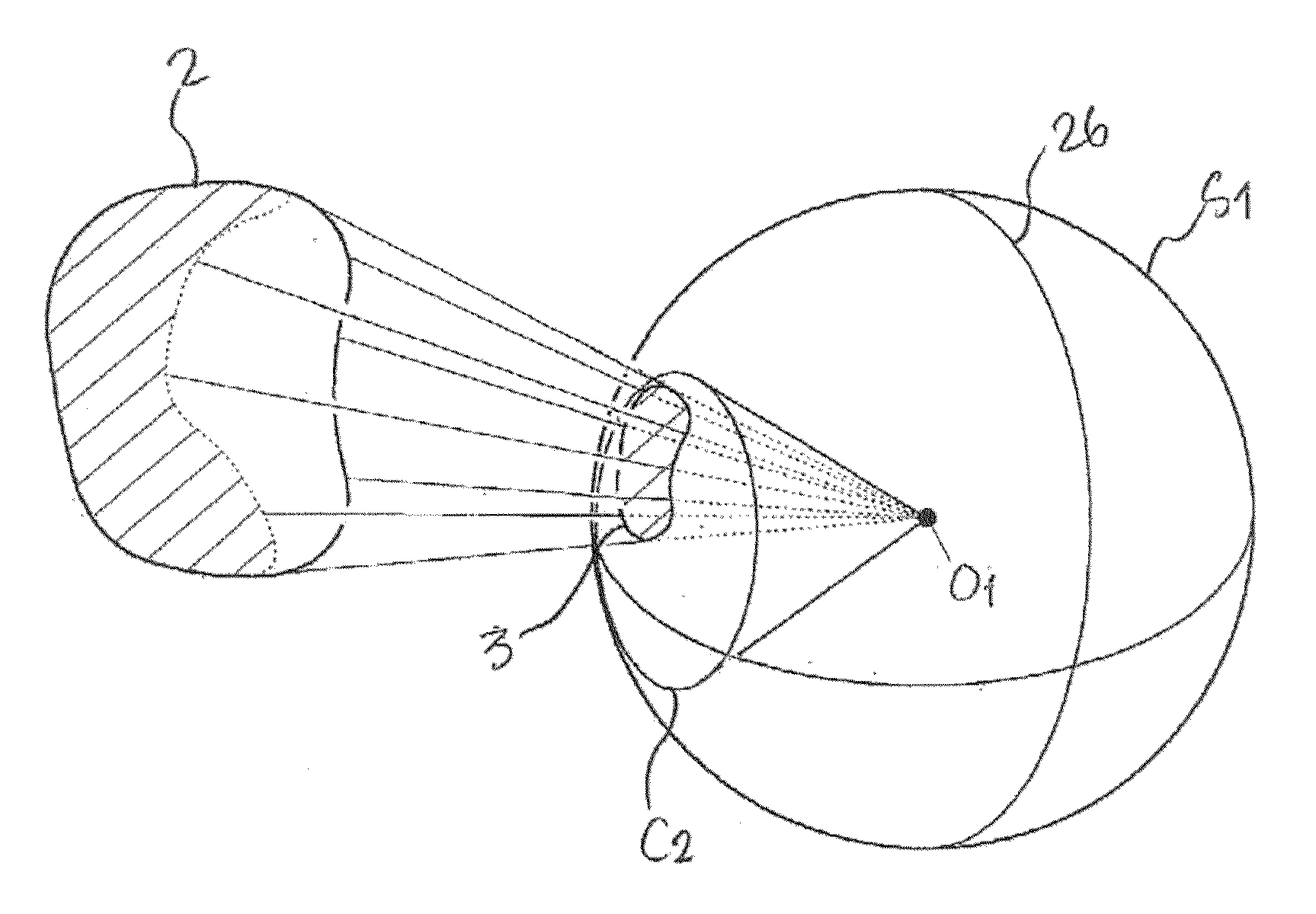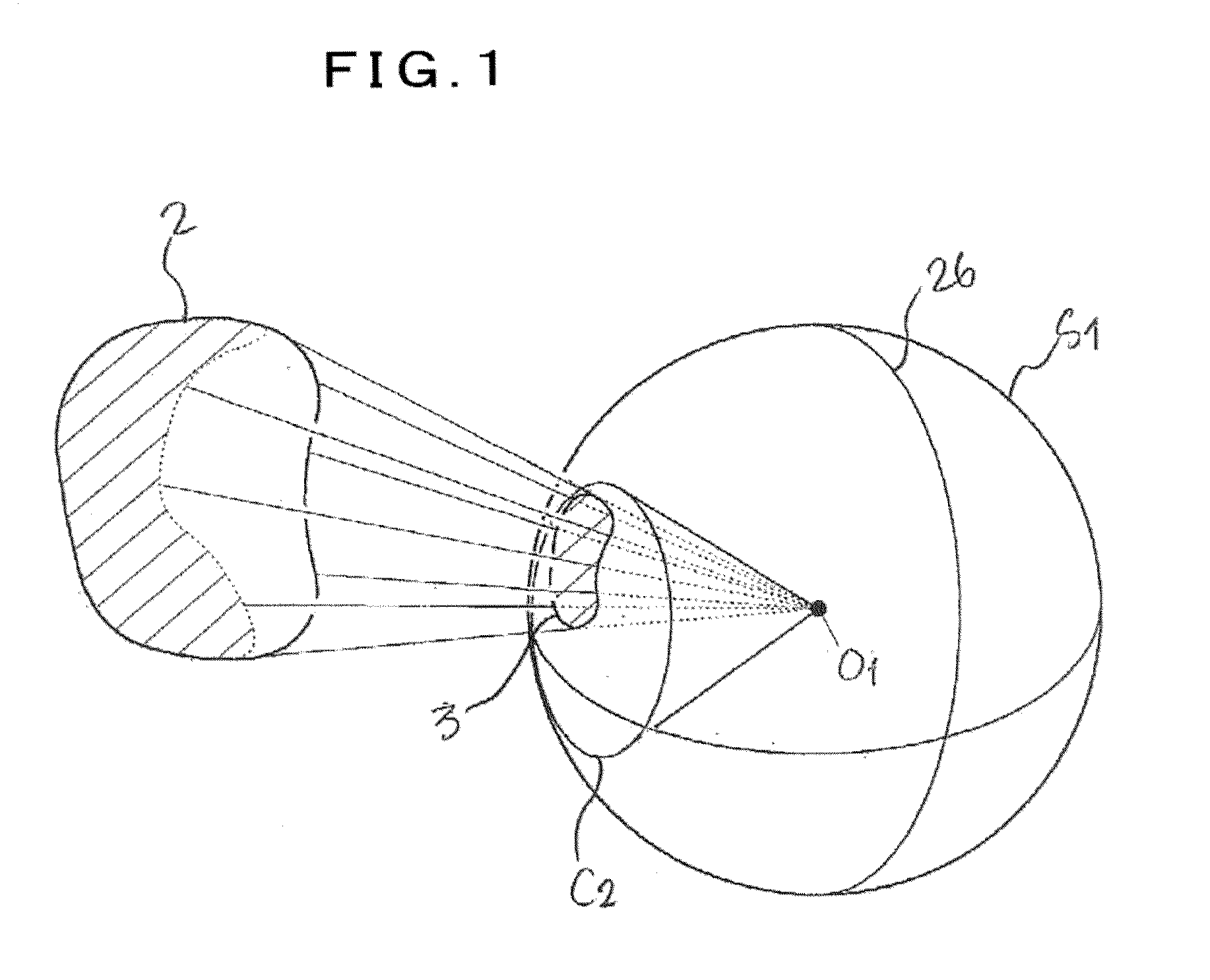Information Processing Method
a technology of information processing and information, applied in the field of information processing methods, can solve the problems of large distortions in the image, all of the above-mentioned existing techniques are defective in one aspect, and the distortions become too large for a user to properly figure out the subjects, etc., to achieve the effect of maintaining the area ratio, reducing local distortions, and maintaining the area ratio
- Summary
- Abstract
- Description
- Claims
- Application Information
AI Technical Summary
Benefits of technology
Problems solved by technology
Method used
Image
Examples
tenth embodiment
[0161]The invention includes a method of mapping an entire surface image of a desired object onto a rectangular plane possibly via a mapping on a sphere. FIG. 37 shows a cross-sectional view of an object obj1 that is a human head. A spherical image 162 is obtained by dividing an entire surface of the object obj1 into regions, next capturing each divisional region by setting an internal optic axis of each component camera from all direction and then mapping these captured images on the sphere 162. The obtained spherical image is flattened out to generate a rectangular image according to the invention. The object obj1 can be mapped directly on a tetrahedron without a mapping process on a sphere.
eleventh embodiment
[0162]The invention includes an iso-area mapping and multi-layer-mapping applied to arbitrary 3-D objects. FIGS. 38 and 39 schematically show a multi-layer-mapping process of a substantially entire surface of an arbitrary object on an octahedron. In FIG. 38 single dot and dash lines 155 and 156 equally divide an entire surface of an object obj3 (in this illustration, a head) into eight regions. One of the regions is a hatched region AR1. Geometry of the region AR1 and other regions can be described by many polygons. In other words, the polygons compose many pyramids. One of them is a pyramid AR2. In its detailed illustration, triangles SR4, SR5 and SR6 compose pyramid surfaces of AR2 and are mapped on triangles SR4a, SR5a and SR6a on its base triangle defined by vertices 157,158 and 171. Thus, the mapping unifies some polygons to one polygon by maintaining an area ratio of SR4:SR5:SR6 to be equal to SR4a:SR5a:SR6a so as to be an iso-area mapping.
[0163]FIG. 39 shows an object obj2 ob...
twelfth embodiment
[0164]The invention includes a rectangular interface for image operation while commanding an entire visual field. A projection of an omnidirectional image on a spherical screen, such as a dome theatre needs several cameras, typically component cameras of a composite camera unit, for input and several projectors for output for dividing and sharing visual fields. An existing interface does not maintain solid angles of input and / or output image, and causes distortion in a displayed image. This makes it difficult for an operator to figure out each divisional image and its connection to an adjacent one. The method arranges individual divisional images from respective cameras in a rectangular interface format while maintaining solid angles of their visual field. Thus, the method enables user to operate images for constructing an omnidirectional image while commanding an entire view with proper solid angle.
[0165]FIG. 40 shows a rectangular region TM3 utilizing a tetrahedral development whi...
PUM
 Login to View More
Login to View More Abstract
Description
Claims
Application Information
 Login to View More
Login to View More - R&D
- Intellectual Property
- Life Sciences
- Materials
- Tech Scout
- Unparalleled Data Quality
- Higher Quality Content
- 60% Fewer Hallucinations
Browse by: Latest US Patents, China's latest patents, Technical Efficacy Thesaurus, Application Domain, Technology Topic, Popular Technical Reports.
© 2025 PatSnap. All rights reserved.Legal|Privacy policy|Modern Slavery Act Transparency Statement|Sitemap|About US| Contact US: help@patsnap.com



